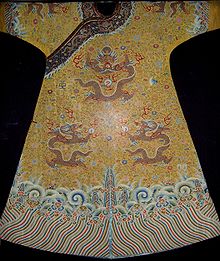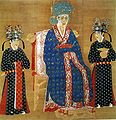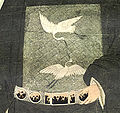- Chinese clothing
-
Chinese clothing is the clothing, ancient and modern, worn by the Chinese people. It has varied by region and time, and is recorded by the artifacts and arts of Chinese culture.
Contents
History
Dynastic China
Main article: Han Chinese clothingTraditional Chinese clothing is broadly referred to as hanfu with many variations such as traditional Chinese academic dress. Japanese clothes and Chinese clothes are very similar. Depending on one's status in society, each social class had a different sense of fashion. Most Chinese men wore Chinese black cotton shoes, but wealthy higher class people would wear tough black leather shoes for formal occasions. Very rich and wealthy men would wear very bright, beautiful silk shoes sometimes having leather on the inside. Women would wear bright, silk coated Lotus shoes under their bound feet. Male shoes were mostly less elaborate than women's.
Civil and military officials
Chinese civil or military officials used a variety of codes to show their rank and position. The most recognized is the Mandarin square or rank badge. Another code was also the use of colorful hat knobs fixed on the top of their hats. The specific hat knob on one's hat determined one's rank. As there were twelve types of hat knobs representing the nine distinctive ranks of the civil or military position. Variations existed for Ming official headwear.
 The Night Revels of Han Xizai painting, originally by Gu Hongzhong, depicting life in the Five Dynasties and Ten Kingdoms Period
The Night Revels of Han Xizai painting, originally by Gu Hongzhong, depicting life in the Five Dynasties and Ten Kingdoms Period Robe of Qianlong Emperor with the Chinese dragon, hallmark of the Emperor of China and imperial families
Robe of Qianlong Emperor with the Chinese dragon, hallmark of the Emperor of China and imperial families
Qing Dynasty (1644–1911)
The rise of the Manchu Qing Dynasty in many ways represented a cultural rupture with the past, as Manchu clothing styles were required to be worn by all noblemen and officials. This style eventually became popular among the commoners.[1] A new style of dress, called tangzhuang, included the changshan worn by men and the qipao worn by women. Manchu official headwear differed from the Ming version but the Qing continued to use the Mandarin square.
Republican era
 Two women wearing cheongsams in a 1930s Shanghai advertisement.
Two women wearing cheongsams in a 1930s Shanghai advertisement.
The abolition of imperial China in 1912 had an immediate effect on dress and customs. The largely Han Chinese population immediately cut off their queue as they were forced to grow in submission to the overthrown Qing Dynasty. Sun Yat-sen popularised a new style of men's wear, featuring jacket and trousers instead of the robes worn previously. Adapted from Japanese student wear, this style of dress became known as the Zhongshan suit (Zhongshan being one of Sun Yat-sen's given names in Chinese).
For women, a transformation of the traditional qipao (cheongsam) resulted in a slender and form fitting dress with a high cut, resulting in the contemporary image of a cheongsam but contrasting sharply with the traditional qipao.
Early People's Republic
Early in the People's Republic, Mao Zedong would inspire Chinese fashion with his own variant of the Zhongshan suit, which would be known to the west as Mao suit. Meanwhile, Sun Yat-sen's widow, Soong Ching-ling, popularised the cheongsam as the standard female dress. At the same time, old practices such as footbinding, which had been viewed as backwards and unmodern by both the Chinese as well as Westerners, were forbidden.
Around the Destruction of the "Four Olds" period in 1964, almost anything seen as part of Traditional Chinese culture would lead to problems with the Communist Red Guards. Items that attracted dangerous attention if caught in the public included jeans, high heels, Western-style coats, ties, jewelry, cheongsams, and long hair.[2] These items were regarded as symbols of bourgeois lifestyle, which represented wealth. Citizens had to avoid them or suffer serious consequences such as torture or beatings by the guards.[2] A number of these items were thrown into the streets to embarrass the citizens.[3]
Image gallery
-
Jade burial suit fashion
-
Emperor Wu of Jìn, by Yan Liben (600–673)
-
Tang Dynasty court ladies from the tomb of Princess Yongtai in the Qianling Mausoleum, near Xi'an in Shaanxi
-
Official Song Dynasty portrait painting of Empress Cao, wife of Emperor Renzong of Song
-
Ming Dynasty Empress Xiao'an
-
A Ming Dynasty portrait of the Chinese official Jiang Shunfu (1453–1504). The decoration of two cranes on his chest are a Mandarin square "rank badge" that indicate he was a civil official of the first rank.
-
The Qing Dynasty Qianlong Emperor in ceremonial armour on horseback
-
Officers of the Chinese Consolidated Benevolent Association in the United States in tangzhuang dress, with riding jackets (馬掛) over changshan.
-
Old Chinese garb from the early to mid-20th century
See also
- Culture of China
- National costume
- China
- Chinese language
- Chinese history
References
- ^ Manchus and Han: Ethnic Relations and Political Power in Late Qing and Early Republican China, 1861-1928 by Edward Rhoads, pg. 61
- ^ a b Law, Kam-yee. [2003] (2003). The Chinese Cultural Revolution Reconsidered: beyond purge and Holocaust. ISBN 0333738357
- ^ Wen, Chihua. Madsen, Richard P. [1995] (1995). The Red Mirror: Children of China's Cultural Revolution. Westview Press. ISBN 0813324882
External links
Categories:- Chinese clothing
- History of Asian clothing
-
Wikimedia Foundation. 2010.













